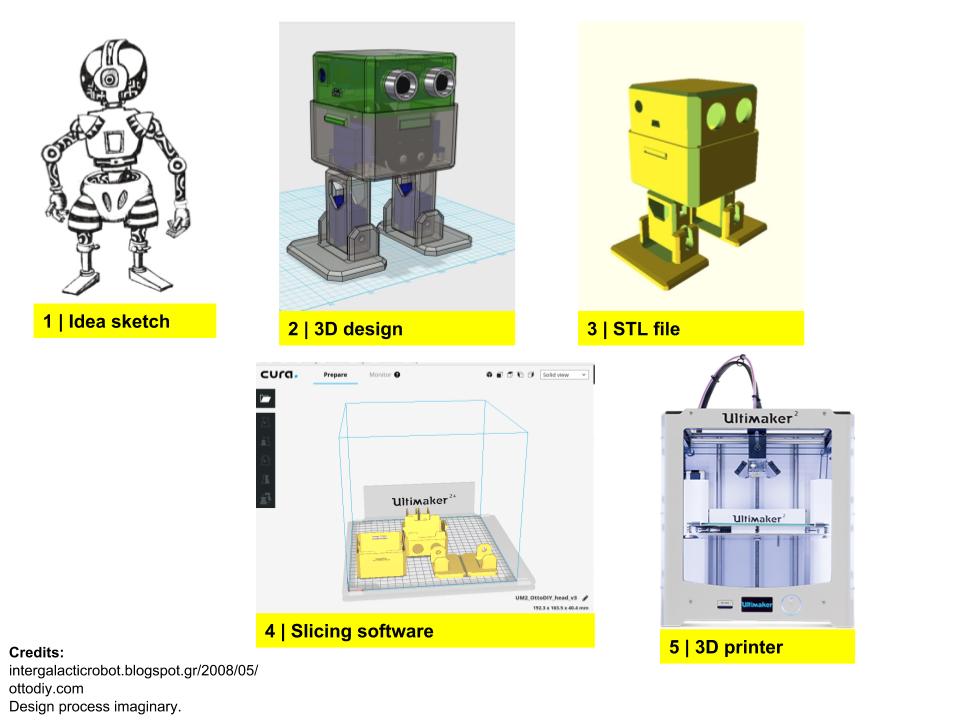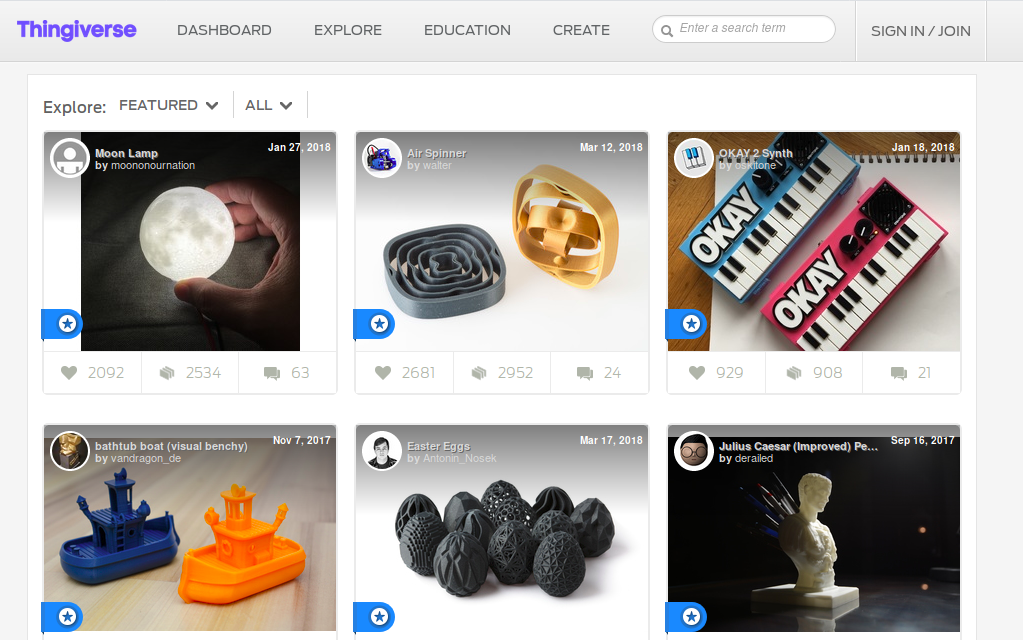From design to print
| Site: | ΕΛ/ΛΑΚ Moodle |
| Course: | 3D printing with circuits and Arduino |
| Book: | From design to print |
| Printed by: | Guest user |
| Date: | Friday, 28 November 2025, 8:01 PM |
Description
Finding and/or creating 3d models, slicing, and preparing to print.
1. The first steps of the design process
3D printing is rather unique because it enables people to make complete, complex solid objects for endless different purposes. As every creative process though, everything starts with an idea.

Ideas
V: Beneath this mask there is more than flesh, Beneath this mask there is an idea, Mr. Creedy, and ideas are bulletproof.
- V for Vendetta
The creative design process might seem at first a rather difficult task. After all computer programs for 3D design might not look friendly to the user and 3D printers -alas- come with several physical constraints. In this course, we invite you to overcome your fears, doubts and uncertainties about creativity; we will provide simple tips, tricks, tools and puzzles for you to be able to make your ideas live.
Observe: Ideas many times come from simply experiencing the world around us. Look around and then change your place and look once more!
Sketch: You don’t need to be a professional artist to put an idea on paper. It is faster than designing directly with a computer program and it allows you to see any mistakes or make changes early on.
3D models
3D design: A 3D model is where your design is finalised as a digital file, with accurate measurements and details. Below are some free tools you can use to design in 3D.
 |
Tinkercad | TinkerCAD is a free browser-based 3D solid modelling tool for rapid
prototyping known for its simple interface and entry-level ease of use. This is the tool we will be using in this section of the course. |
|---|---|---|
| OpenSCAD | "The Programmers Solid 3D CAD Modeller" - OpenSCAD is a free software application for creating solid 3D CAD (computer-aided design) objects. It is a script-only based modeller that uses its own description language; parts can be previewed but cannot be interactively selected or modified by mouse in the 3D view. | |
| Blender | Blender is a professional free and open-source 3D computer graphics software product used for creating animated films, visual effects, art, 3D printed models, interactive 3D applications and video games. Blender's features include 3D modeling, UV unwrapping, texturing, raster graphics editing, rigging and skinning, fluid and smoke simulation, particle simulation, soft body simulation, sculpting, animating, match moving, camera tracking, rendering, video editing and compositing. It further features an integrated game engine. |
Export: In order to be ready for 3D print, the model must be exported as a polygon mesh model. STL is the most common format for exporting geometry for 3D printing.
Print-ready files
Prepare: Before printing a 3D model, it must first be examined for any design errors that would result in a failed print. In the preparation software, you can also move your models, scale and rotate them and add their copies or additional models. Some models also require the creation of support structures for 3D printing.
Slice: Once completed, the STL file needs to be processed by a piece of software called a "slicer," which converts the model into a series of thin layers and produces a G-code file containing instructions tailored to a specific type of 3D printer. G-code is basically a set of instructions/toolpaths for the machines to follow.
Cura is one of many applications that prepares your STL, slices it into layers and converts it to G-code suitable to your printer.
2. Finding open designs online
If you just want to try 3D printing without having to design something, you can also find free, open designs online in one of the many repositories that exist.
Thingiverse - https://www.thingiverse.com/
One of the most popular free repositories, Thingiverse is an online platform for discovering, making, and sharing 3D printable things, operated by MakerBot.

YouMagine - https://www.youmagine.com/
YouMagine is a community website operated by Ultimaker.
Libre3D - http://libre3d.com/
This site is dedicated to being a source for 3d printer help, printable 3d object files, and much more, with a focus on the open source 3d community.
NASA 3D Resources - https://nasa3d.arc.nasa.gov/models/printable
3D printable models created by NASA.
Cults 3D - https://cults3d.com/en
Digital marketplace for 3D printing and design.
Pinshape - https://pinshape.com
Selection of premium and free STL files for download and print.
NIH 3D Print Exchange - https://3dprint.nih.gov/
3D printable models related to biomedical science.
Embodi3D - https://www.embodi3d.com/files/
Biomedical 3D printing community.
GrabCAD - https://grabcad.com/library
Online library with free engineering CAD files.
3. Getting started with Cura
In this chapter, you will learn how to prepare and slice your model for 3D printing with Cura.
This tutorial covers basic 3D printing skills and beyond. For future reference, it is worth checking out Cura's expert settings.